Authentication Processes: A Comprehensive Analysis of Methods
VerifiedAdded on 2022/12/19
|11
|1686
|240
Report
AI Summary
This report provides a comprehensive overview of authentication processes, crucial for securing systems and managing user identities. It delves into four primary authentication methods: Active Directory (simple passwords), one-time passwords (OTP), public key cryptography, and digital certificates. Each method is examined in detail, including its advantages, disadvantages, and practical applications within organizations. The report highlights the importance of considering security and privacy when implementing authentication methods and suggests that companies should focus on proper configuration and the development of robust security policies. The document concludes by emphasizing the effectiveness of authentication in protecting data and information, providing a valuable resource for understanding and improving security practices in the workplace.

AUTHENTICATION PROCESSES 0
Paraphrase This Document
Need a fresh take? Get an instant paraphrase of this document with our AI Paraphraser
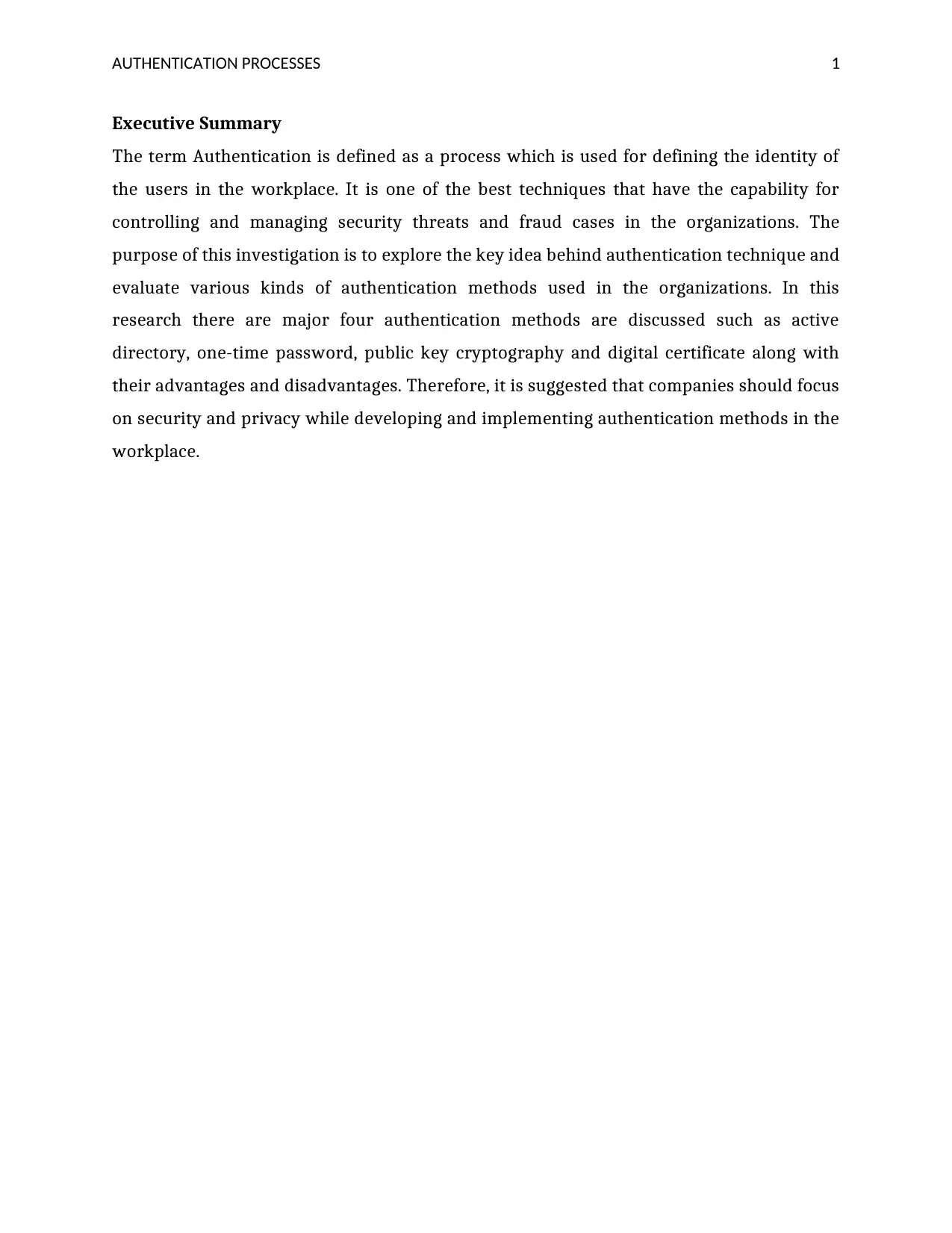
AUTHENTICATION PROCESSES 1
Executive Summary
The term Authentication is defined as a process which is used for defining the identity of
the users in the workplace. It is one of the best techniques that have the capability for
controlling and managing security threats and fraud cases in the organizations. The
purpose of this investigation is to explore the key idea behind authentication technique and
evaluate various kinds of authentication methods used in the organizations. In this
research there are major four authentication methods are discussed such as active
directory, one-time password, public key cryptography and digital certificate along with
their advantages and disadvantages. Therefore, it is suggested that companies should focus
on security and privacy while developing and implementing authentication methods in the
workplace.
Executive Summary
The term Authentication is defined as a process which is used for defining the identity of
the users in the workplace. It is one of the best techniques that have the capability for
controlling and managing security threats and fraud cases in the organizations. The
purpose of this investigation is to explore the key idea behind authentication technique and
evaluate various kinds of authentication methods used in the organizations. In this
research there are major four authentication methods are discussed such as active
directory, one-time password, public key cryptography and digital certificate along with
their advantages and disadvantages. Therefore, it is suggested that companies should focus
on security and privacy while developing and implementing authentication methods in the
workplace.
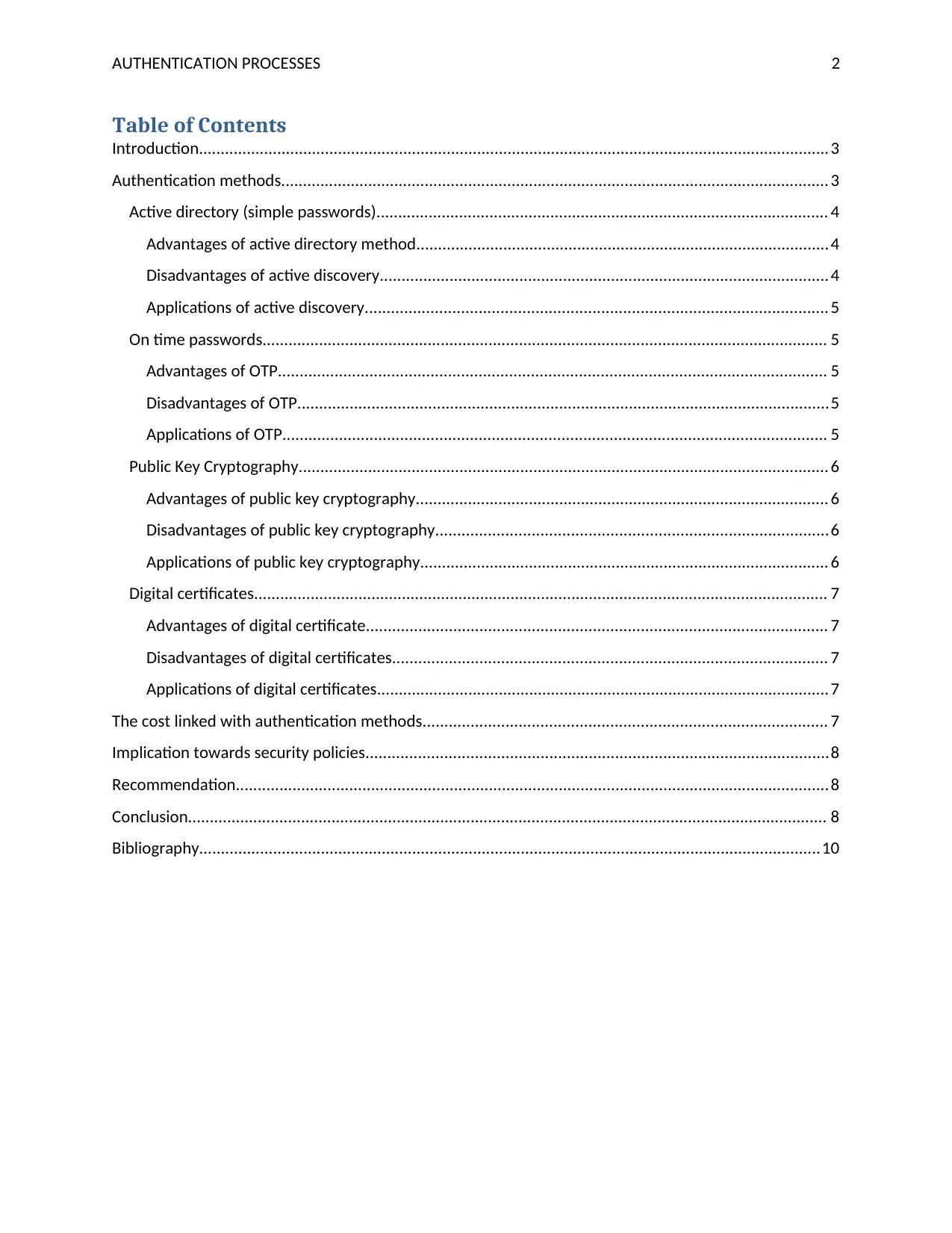
AUTHENTICATION PROCESSES 2
Table of Contents
Introduction.................................................................................................................................................3
Authentication methods.............................................................................................................................. 3
Active directory (simple passwords)........................................................................................................ 4
Advantages of active directory method...............................................................................................4
Disadvantages of active discovery.......................................................................................................4
Applications of active discovery.......................................................................................................... 5
On time passwords.................................................................................................................................. 5
Advantages of OTP.............................................................................................................................. 5
Disadvantages of OTP..........................................................................................................................5
Applications of OTP............................................................................................................................. 5
Public Key Cryptography.......................................................................................................................... 6
Advantages of public key cryptography............................................................................................... 6
Disadvantages of public key cryptography..........................................................................................6
Applications of public key cryptography.............................................................................................. 6
Digital certificates.................................................................................................................................... 7
Advantages of digital certificate.......................................................................................................... 7
Disadvantages of digital certificates.................................................................................................... 7
Applications of digital certificates........................................................................................................ 7
The cost linked with authentication methods............................................................................................. 7
Implication towards security policies..........................................................................................................8
Recommendation........................................................................................................................................8
Conclusion................................................................................................................................................... 8
Bibliography...............................................................................................................................................10
Table of Contents
Introduction.................................................................................................................................................3
Authentication methods.............................................................................................................................. 3
Active directory (simple passwords)........................................................................................................ 4
Advantages of active directory method...............................................................................................4
Disadvantages of active discovery.......................................................................................................4
Applications of active discovery.......................................................................................................... 5
On time passwords.................................................................................................................................. 5
Advantages of OTP.............................................................................................................................. 5
Disadvantages of OTP..........................................................................................................................5
Applications of OTP............................................................................................................................. 5
Public Key Cryptography.......................................................................................................................... 6
Advantages of public key cryptography............................................................................................... 6
Disadvantages of public key cryptography..........................................................................................6
Applications of public key cryptography.............................................................................................. 6
Digital certificates.................................................................................................................................... 7
Advantages of digital certificate.......................................................................................................... 7
Disadvantages of digital certificates.................................................................................................... 7
Applications of digital certificates........................................................................................................ 7
The cost linked with authentication methods............................................................................................. 7
Implication towards security policies..........................................................................................................8
Recommendation........................................................................................................................................8
Conclusion................................................................................................................................................... 8
Bibliography...............................................................................................................................................10
⊘ This is a preview!⊘
Do you want full access?
Subscribe today to unlock all pages.

Trusted by 1+ million students worldwide
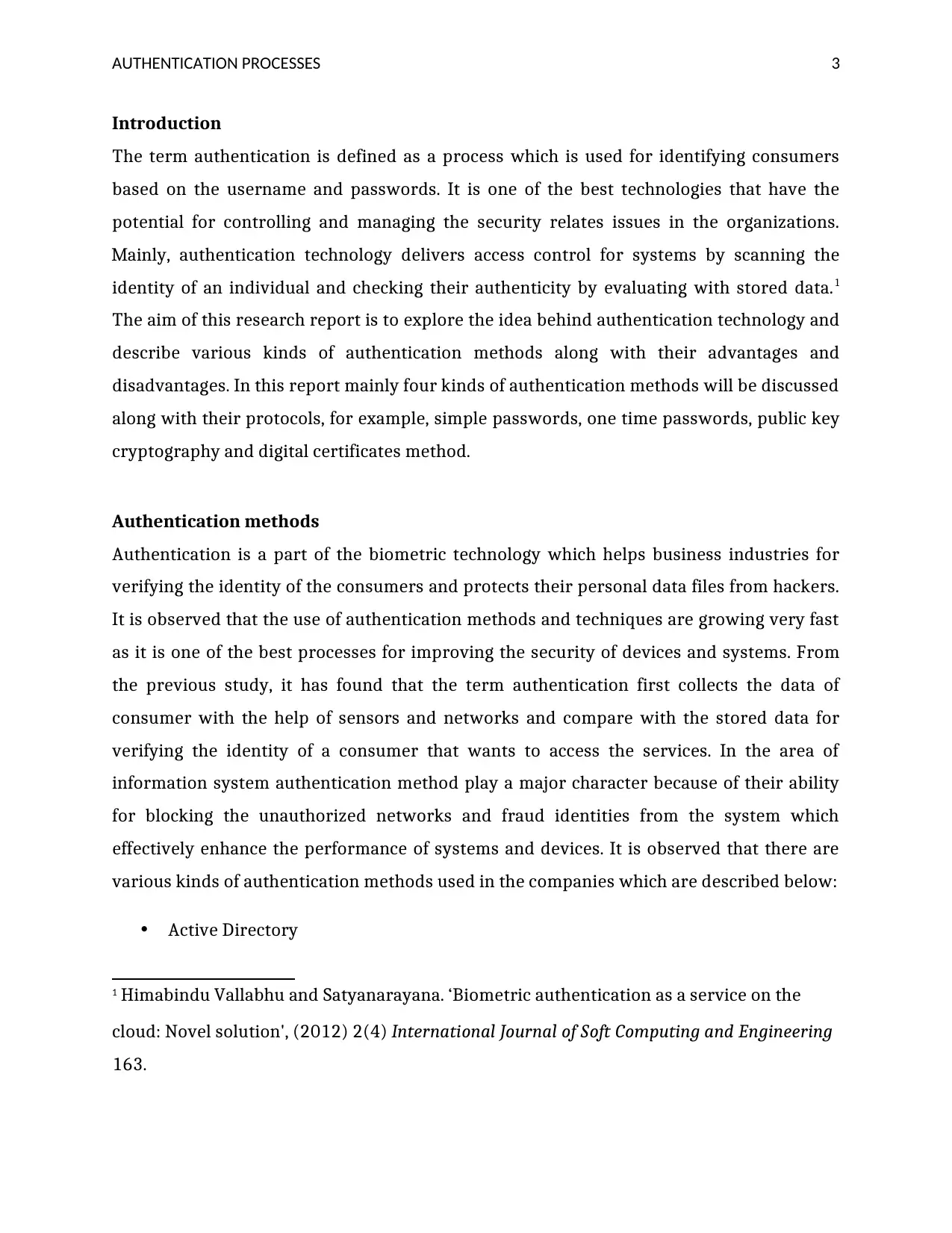
AUTHENTICATION PROCESSES 3
Introduction
The term authentication is defined as a process which is used for identifying consumers
based on the username and passwords. It is one of the best technologies that have the
potential for controlling and managing the security relates issues in the organizations.
Mainly, authentication technology delivers access control for systems by scanning the
identity of an individual and checking their authenticity by evaluating with stored data.1
The aim of this research report is to explore the idea behind authentication technology and
describe various kinds of authentication methods along with their advantages and
disadvantages. In this report mainly four kinds of authentication methods will be discussed
along with their protocols, for example, simple passwords, one time passwords, public key
cryptography and digital certificates method.
Authentication methods
Authentication is a part of the biometric technology which helps business industries for
verifying the identity of the consumers and protects their personal data files from hackers.
It is observed that the use of authentication methods and techniques are growing very fast
as it is one of the best processes for improving the security of devices and systems. From
the previous study, it has found that the term authentication first collects the data of
consumer with the help of sensors and networks and compare with the stored data for
verifying the identity of a consumer that wants to access the services. In the area of
information system authentication method play a major character because of their ability
for blocking the unauthorized networks and fraud identities from the system which
effectively enhance the performance of systems and devices. It is observed that there are
various kinds of authentication methods used in the companies which are described below:
Active Directory
1 Himabindu Vallabhu and Satyanarayana. ‘Biometric authentication as a service on the
cloud: Novel solution', (2012) 2(4) International Journal of Soft Computing and Engineering
163.
Introduction
The term authentication is defined as a process which is used for identifying consumers
based on the username and passwords. It is one of the best technologies that have the
potential for controlling and managing the security relates issues in the organizations.
Mainly, authentication technology delivers access control for systems by scanning the
identity of an individual and checking their authenticity by evaluating with stored data.1
The aim of this research report is to explore the idea behind authentication technology and
describe various kinds of authentication methods along with their advantages and
disadvantages. In this report mainly four kinds of authentication methods will be discussed
along with their protocols, for example, simple passwords, one time passwords, public key
cryptography and digital certificates method.
Authentication methods
Authentication is a part of the biometric technology which helps business industries for
verifying the identity of the consumers and protects their personal data files from hackers.
It is observed that the use of authentication methods and techniques are growing very fast
as it is one of the best processes for improving the security of devices and systems. From
the previous study, it has found that the term authentication first collects the data of
consumer with the help of sensors and networks and compare with the stored data for
verifying the identity of a consumer that wants to access the services. In the area of
information system authentication method play a major character because of their ability
for blocking the unauthorized networks and fraud identities from the system which
effectively enhance the performance of systems and devices. It is observed that there are
various kinds of authentication methods used in the companies which are described below:
Active Directory
1 Himabindu Vallabhu and Satyanarayana. ‘Biometric authentication as a service on the
cloud: Novel solution', (2012) 2(4) International Journal of Soft Computing and Engineering
163.
Paraphrase This Document
Need a fresh take? Get an instant paraphrase of this document with our AI Paraphraser
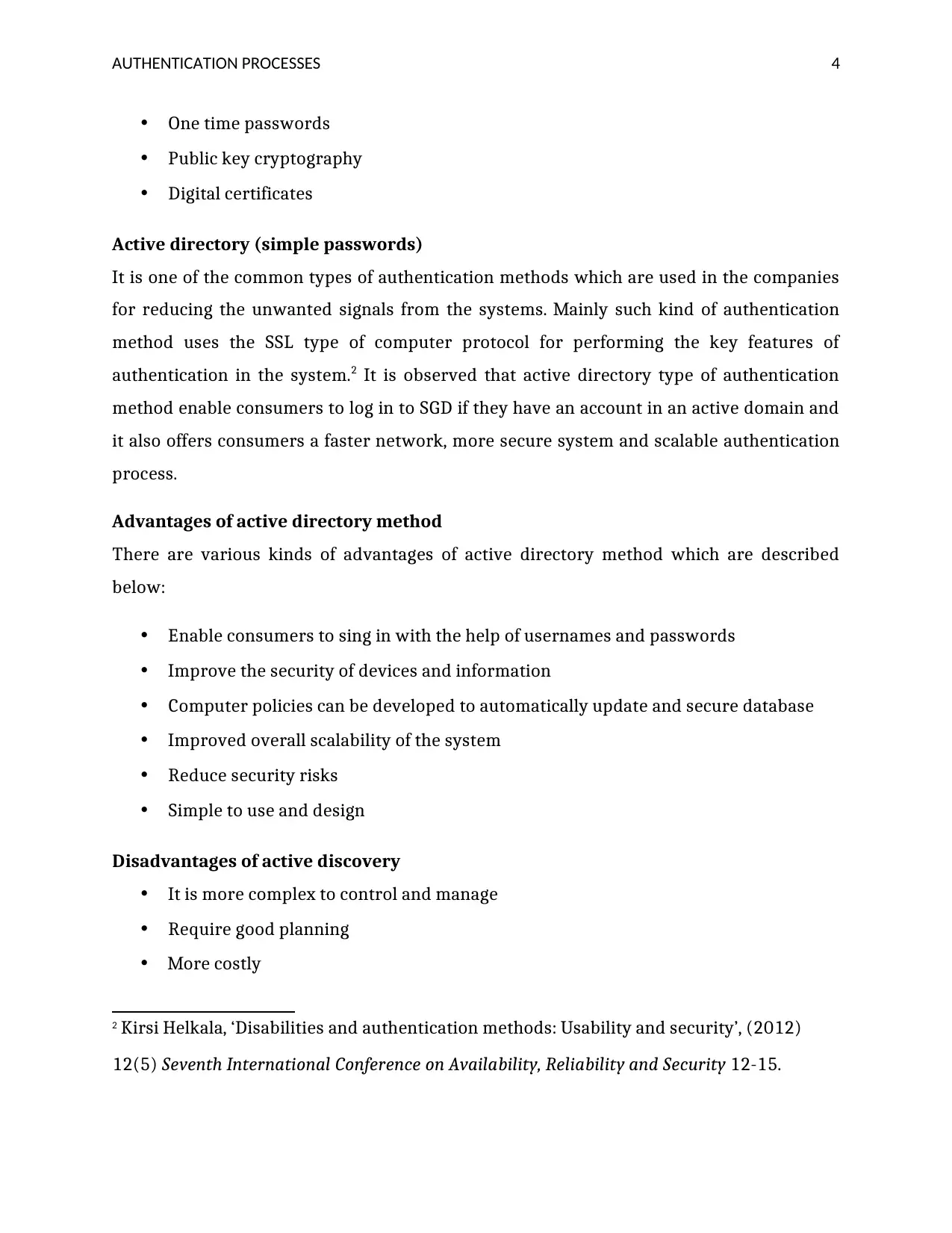
AUTHENTICATION PROCESSES 4
One time passwords
Public key cryptography
Digital certificates
Active directory (simple passwords)
It is one of the common types of authentication methods which are used in the companies
for reducing the unwanted signals from the systems. Mainly such kind of authentication
method uses the SSL type of computer protocol for performing the key features of
authentication in the system.2 It is observed that active directory type of authentication
method enable consumers to log in to SGD if they have an account in an active domain and
it also offers consumers a faster network, more secure system and scalable authentication
process.
Advantages of active directory method
There are various kinds of advantages of active directory method which are described
below:
Enable consumers to sing in with the help of usernames and passwords
Improve the security of devices and information
Computer policies can be developed to automatically update and secure database
Improved overall scalability of the system
Reduce security risks
Simple to use and design
Disadvantages of active discovery
It is more complex to control and manage
Require good planning
More costly
2 Kirsi Helkala, ‘Disabilities and authentication methods: Usability and security’, (2012)
12(5) Seventh International Conference on Availability, Reliability and Security 12-15.
One time passwords
Public key cryptography
Digital certificates
Active directory (simple passwords)
It is one of the common types of authentication methods which are used in the companies
for reducing the unwanted signals from the systems. Mainly such kind of authentication
method uses the SSL type of computer protocol for performing the key features of
authentication in the system.2 It is observed that active directory type of authentication
method enable consumers to log in to SGD if they have an account in an active domain and
it also offers consumers a faster network, more secure system and scalable authentication
process.
Advantages of active directory method
There are various kinds of advantages of active directory method which are described
below:
Enable consumers to sing in with the help of usernames and passwords
Improve the security of devices and information
Computer policies can be developed to automatically update and secure database
Improved overall scalability of the system
Reduce security risks
Simple to use and design
Disadvantages of active discovery
It is more complex to control and manage
Require good planning
More costly
2 Kirsi Helkala, ‘Disabilities and authentication methods: Usability and security’, (2012)
12(5) Seventh International Conference on Availability, Reliability and Security 12-15.
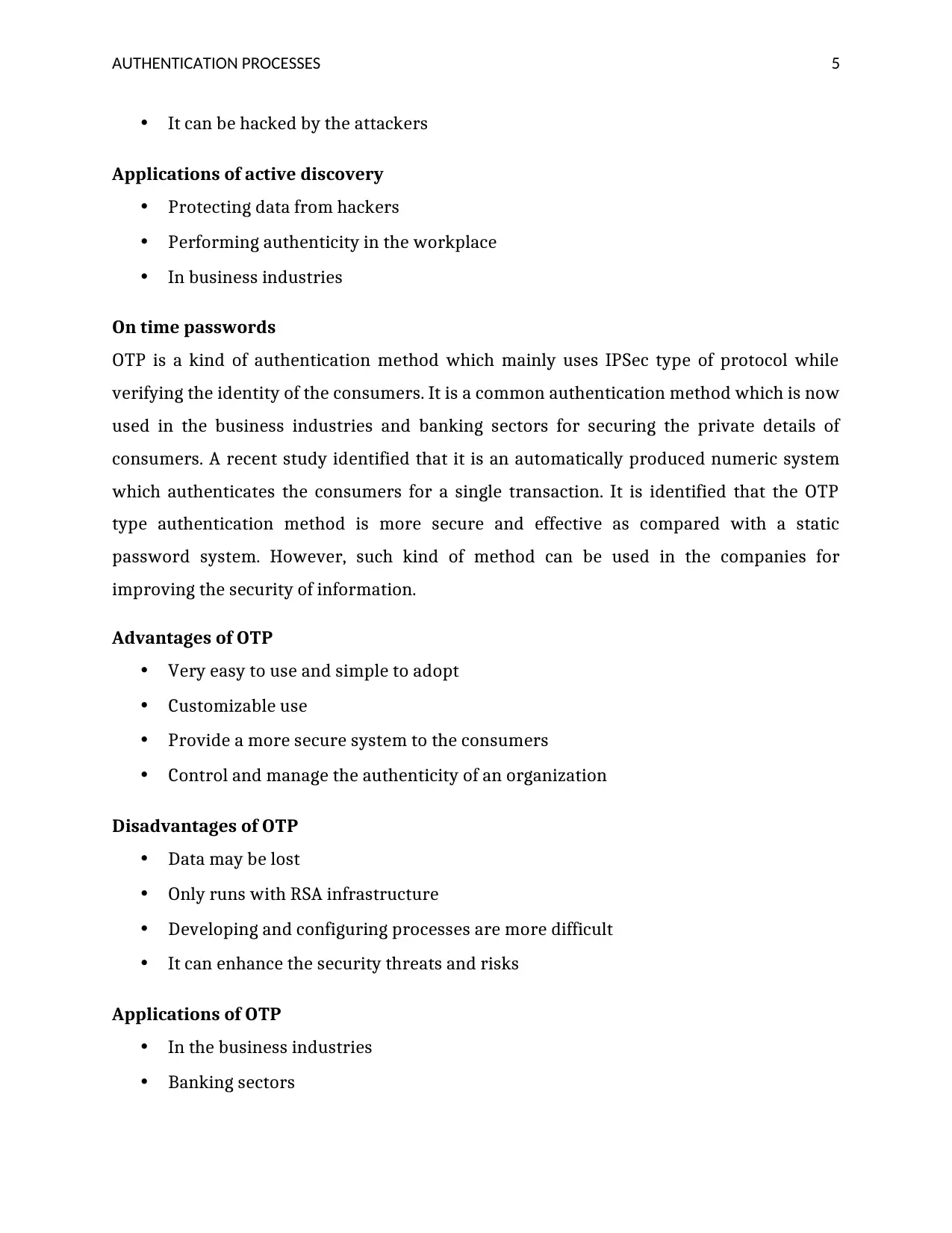
AUTHENTICATION PROCESSES 5
It can be hacked by the attackers
Applications of active discovery
Protecting data from hackers
Performing authenticity in the workplace
In business industries
On time passwords
OTP is a kind of authentication method which mainly uses IPSec type of protocol while
verifying the identity of the consumers. It is a common authentication method which is now
used in the business industries and banking sectors for securing the private details of
consumers. A recent study identified that it is an automatically produced numeric system
which authenticates the consumers for a single transaction. It is identified that the OTP
type authentication method is more secure and effective as compared with a static
password system. However, such kind of method can be used in the companies for
improving the security of information.
Advantages of OTP
Very easy to use and simple to adopt
Customizable use
Provide a more secure system to the consumers
Control and manage the authenticity of an organization
Disadvantages of OTP
Data may be lost
Only runs with RSA infrastructure
Developing and configuring processes are more difficult
It can enhance the security threats and risks
Applications of OTP
In the business industries
Banking sectors
It can be hacked by the attackers
Applications of active discovery
Protecting data from hackers
Performing authenticity in the workplace
In business industries
On time passwords
OTP is a kind of authentication method which mainly uses IPSec type of protocol while
verifying the identity of the consumers. It is a common authentication method which is now
used in the business industries and banking sectors for securing the private details of
consumers. A recent study identified that it is an automatically produced numeric system
which authenticates the consumers for a single transaction. It is identified that the OTP
type authentication method is more secure and effective as compared with a static
password system. However, such kind of method can be used in the companies for
improving the security of information.
Advantages of OTP
Very easy to use and simple to adopt
Customizable use
Provide a more secure system to the consumers
Control and manage the authenticity of an organization
Disadvantages of OTP
Data may be lost
Only runs with RSA infrastructure
Developing and configuring processes are more difficult
It can enhance the security threats and risks
Applications of OTP
In the business industries
Banking sectors
⊘ This is a preview!⊘
Do you want full access?
Subscribe today to unlock all pages.

Trusted by 1+ million students worldwide
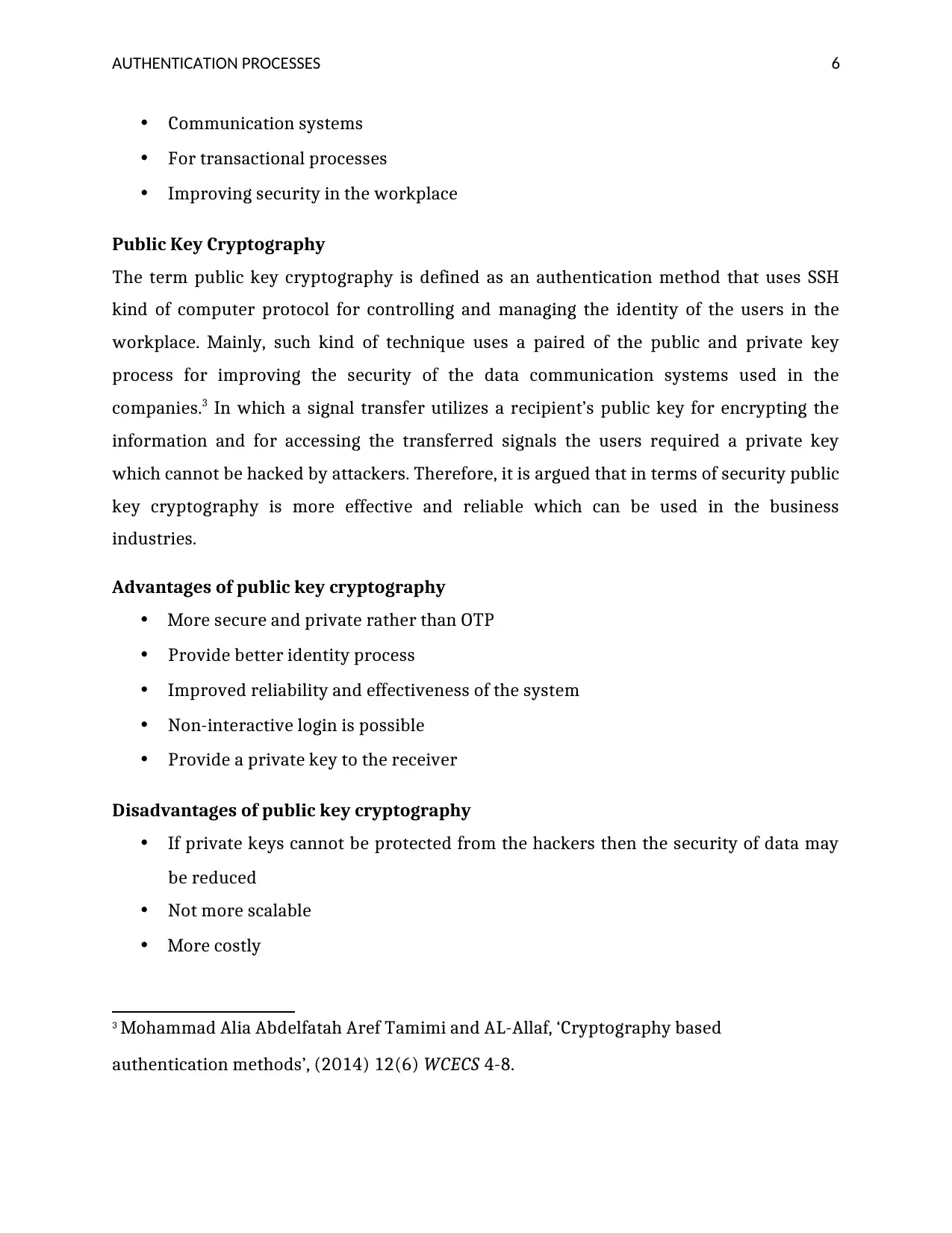
AUTHENTICATION PROCESSES 6
Communication systems
For transactional processes
Improving security in the workplace
Public Key Cryptography
The term public key cryptography is defined as an authentication method that uses SSH
kind of computer protocol for controlling and managing the identity of the users in the
workplace. Mainly, such kind of technique uses a paired of the public and private key
process for improving the security of the data communication systems used in the
companies.3 In which a signal transfer utilizes a recipient’s public key for encrypting the
information and for accessing the transferred signals the users required a private key
which cannot be hacked by attackers. Therefore, it is argued that in terms of security public
key cryptography is more effective and reliable which can be used in the business
industries.
Advantages of public key cryptography
More secure and private rather than OTP
Provide better identity process
Improved reliability and effectiveness of the system
Non-interactive login is possible
Provide a private key to the receiver
Disadvantages of public key cryptography
If private keys cannot be protected from the hackers then the security of data may
be reduced
Not more scalable
More costly
3 Mohammad Alia Abdelfatah Aref Tamimi and AL-Allaf, ‘Cryptography based
authentication methods’, (2014) 12(6) WCECS 4-8.
Communication systems
For transactional processes
Improving security in the workplace
Public Key Cryptography
The term public key cryptography is defined as an authentication method that uses SSH
kind of computer protocol for controlling and managing the identity of the users in the
workplace. Mainly, such kind of technique uses a paired of the public and private key
process for improving the security of the data communication systems used in the
companies.3 In which a signal transfer utilizes a recipient’s public key for encrypting the
information and for accessing the transferred signals the users required a private key
which cannot be hacked by attackers. Therefore, it is argued that in terms of security public
key cryptography is more effective and reliable which can be used in the business
industries.
Advantages of public key cryptography
More secure and private rather than OTP
Provide better identity process
Improved reliability and effectiveness of the system
Non-interactive login is possible
Provide a private key to the receiver
Disadvantages of public key cryptography
If private keys cannot be protected from the hackers then the security of data may
be reduced
Not more scalable
More costly
3 Mohammad Alia Abdelfatah Aref Tamimi and AL-Allaf, ‘Cryptography based
authentication methods’, (2014) 12(6) WCECS 4-8.
Paraphrase This Document
Need a fresh take? Get an instant paraphrase of this document with our AI Paraphraser
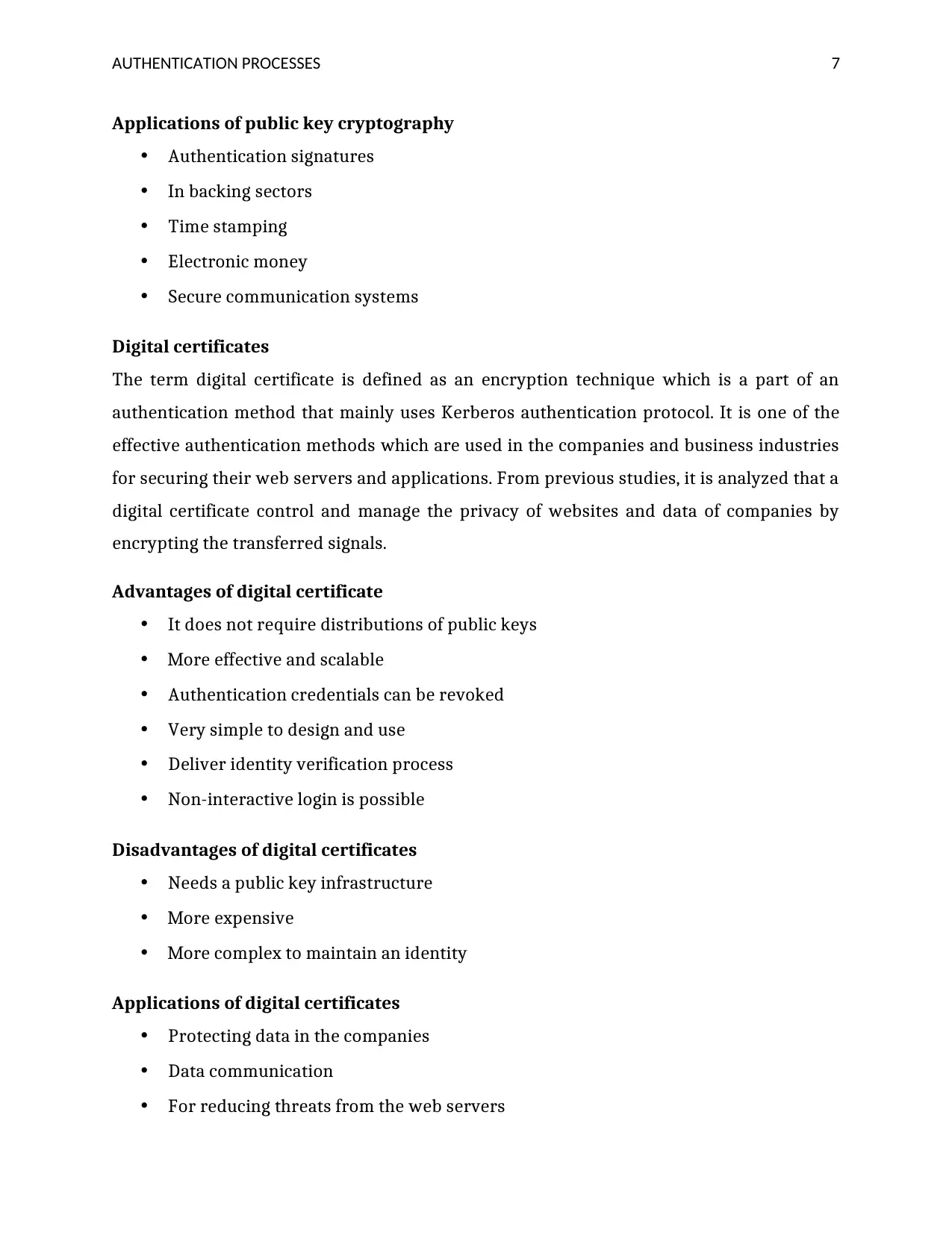
AUTHENTICATION PROCESSES 7
Applications of public key cryptography
Authentication signatures
In backing sectors
Time stamping
Electronic money
Secure communication systems
Digital certificates
The term digital certificate is defined as an encryption technique which is a part of an
authentication method that mainly uses Kerberos authentication protocol. It is one of the
effective authentication methods which are used in the companies and business industries
for securing their web servers and applications. From previous studies, it is analyzed that a
digital certificate control and manage the privacy of websites and data of companies by
encrypting the transferred signals.
Advantages of digital certificate
It does not require distributions of public keys
More effective and scalable
Authentication credentials can be revoked
Very simple to design and use
Deliver identity verification process
Non-interactive login is possible
Disadvantages of digital certificates
Needs a public key infrastructure
More expensive
More complex to maintain an identity
Applications of digital certificates
Protecting data in the companies
Data communication
For reducing threats from the web servers
Applications of public key cryptography
Authentication signatures
In backing sectors
Time stamping
Electronic money
Secure communication systems
Digital certificates
The term digital certificate is defined as an encryption technique which is a part of an
authentication method that mainly uses Kerberos authentication protocol. It is one of the
effective authentication methods which are used in the companies and business industries
for securing their web servers and applications. From previous studies, it is analyzed that a
digital certificate control and manage the privacy of websites and data of companies by
encrypting the transferred signals.
Advantages of digital certificate
It does not require distributions of public keys
More effective and scalable
Authentication credentials can be revoked
Very simple to design and use
Deliver identity verification process
Non-interactive login is possible
Disadvantages of digital certificates
Needs a public key infrastructure
More expensive
More complex to maintain an identity
Applications of digital certificates
Protecting data in the companies
Data communication
For reducing threats from the web servers
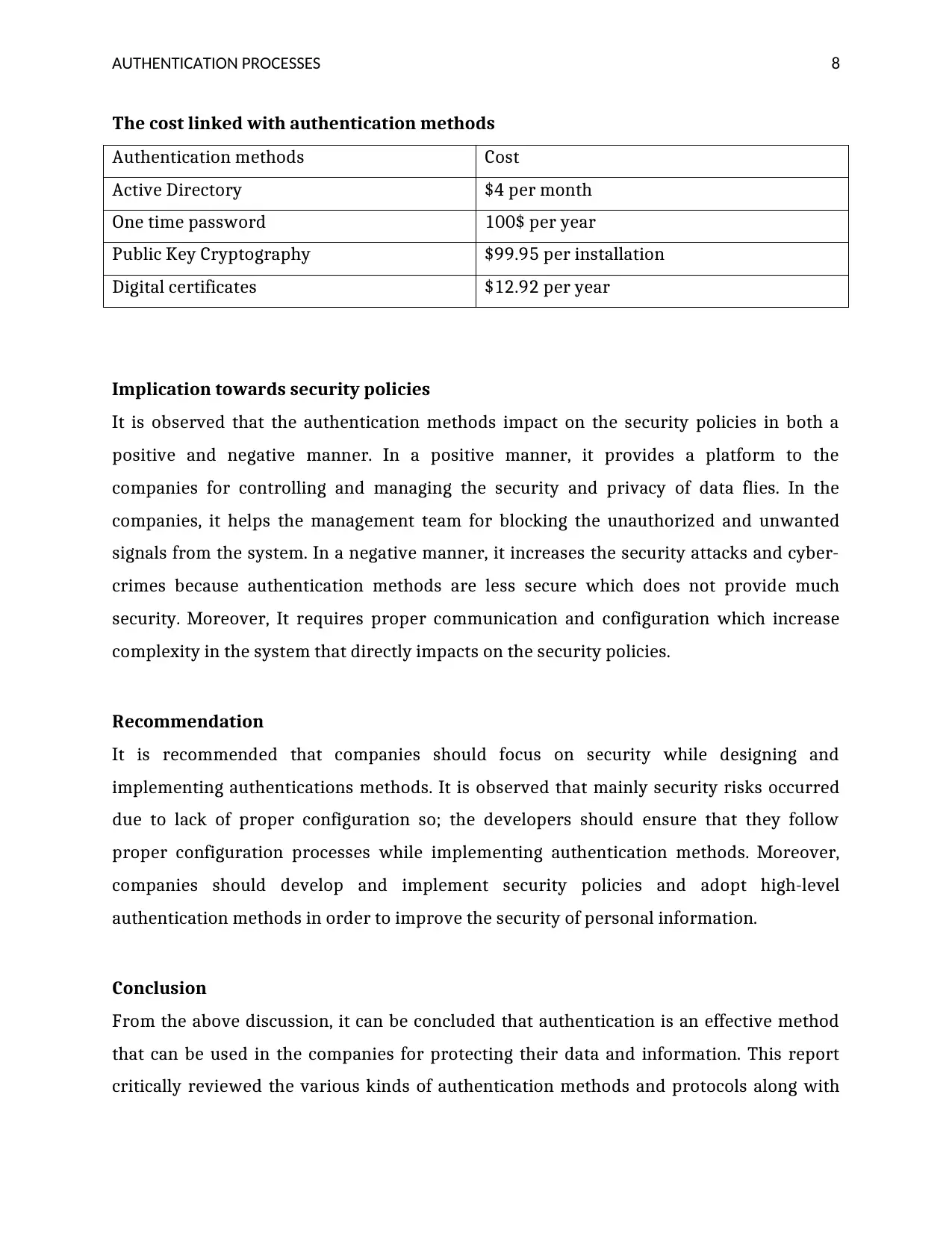
AUTHENTICATION PROCESSES 8
The cost linked with authentication methods
Authentication methods Cost
Active Directory $4 per month
One time password 100$ per year
Public Key Cryptography $99.95 per installation
Digital certificates $12.92 per year
Implication towards security policies
It is observed that the authentication methods impact on the security policies in both a
positive and negative manner. In a positive manner, it provides a platform to the
companies for controlling and managing the security and privacy of data flies. In the
companies, it helps the management team for blocking the unauthorized and unwanted
signals from the system. In a negative manner, it increases the security attacks and cyber-
crimes because authentication methods are less secure which does not provide much
security. Moreover, It requires proper communication and configuration which increase
complexity in the system that directly impacts on the security policies.
Recommendation
It is recommended that companies should focus on security while designing and
implementing authentications methods. It is observed that mainly security risks occurred
due to lack of proper configuration so; the developers should ensure that they follow
proper configuration processes while implementing authentication methods. Moreover,
companies should develop and implement security policies and adopt high-level
authentication methods in order to improve the security of personal information.
Conclusion
From the above discussion, it can be concluded that authentication is an effective method
that can be used in the companies for protecting their data and information. This report
critically reviewed the various kinds of authentication methods and protocols along with
The cost linked with authentication methods
Authentication methods Cost
Active Directory $4 per month
One time password 100$ per year
Public Key Cryptography $99.95 per installation
Digital certificates $12.92 per year
Implication towards security policies
It is observed that the authentication methods impact on the security policies in both a
positive and negative manner. In a positive manner, it provides a platform to the
companies for controlling and managing the security and privacy of data flies. In the
companies, it helps the management team for blocking the unauthorized and unwanted
signals from the system. In a negative manner, it increases the security attacks and cyber-
crimes because authentication methods are less secure which does not provide much
security. Moreover, It requires proper communication and configuration which increase
complexity in the system that directly impacts on the security policies.
Recommendation
It is recommended that companies should focus on security while designing and
implementing authentications methods. It is observed that mainly security risks occurred
due to lack of proper configuration so; the developers should ensure that they follow
proper configuration processes while implementing authentication methods. Moreover,
companies should develop and implement security policies and adopt high-level
authentication methods in order to improve the security of personal information.
Conclusion
From the above discussion, it can be concluded that authentication is an effective method
that can be used in the companies for protecting their data and information. This report
critically reviewed the various kinds of authentication methods and protocols along with
⊘ This is a preview!⊘
Do you want full access?
Subscribe today to unlock all pages.

Trusted by 1+ million students worldwide

AUTHENTICATION PROCESSES 9
their advantages and disadvantages. For improving the security of data companies should
focus on the configuration process and develop security policies in the workplace.
their advantages and disadvantages. For improving the security of data companies should
focus on the configuration process and develop security policies in the workplace.
Paraphrase This Document
Need a fresh take? Get an instant paraphrase of this document with our AI Paraphraser
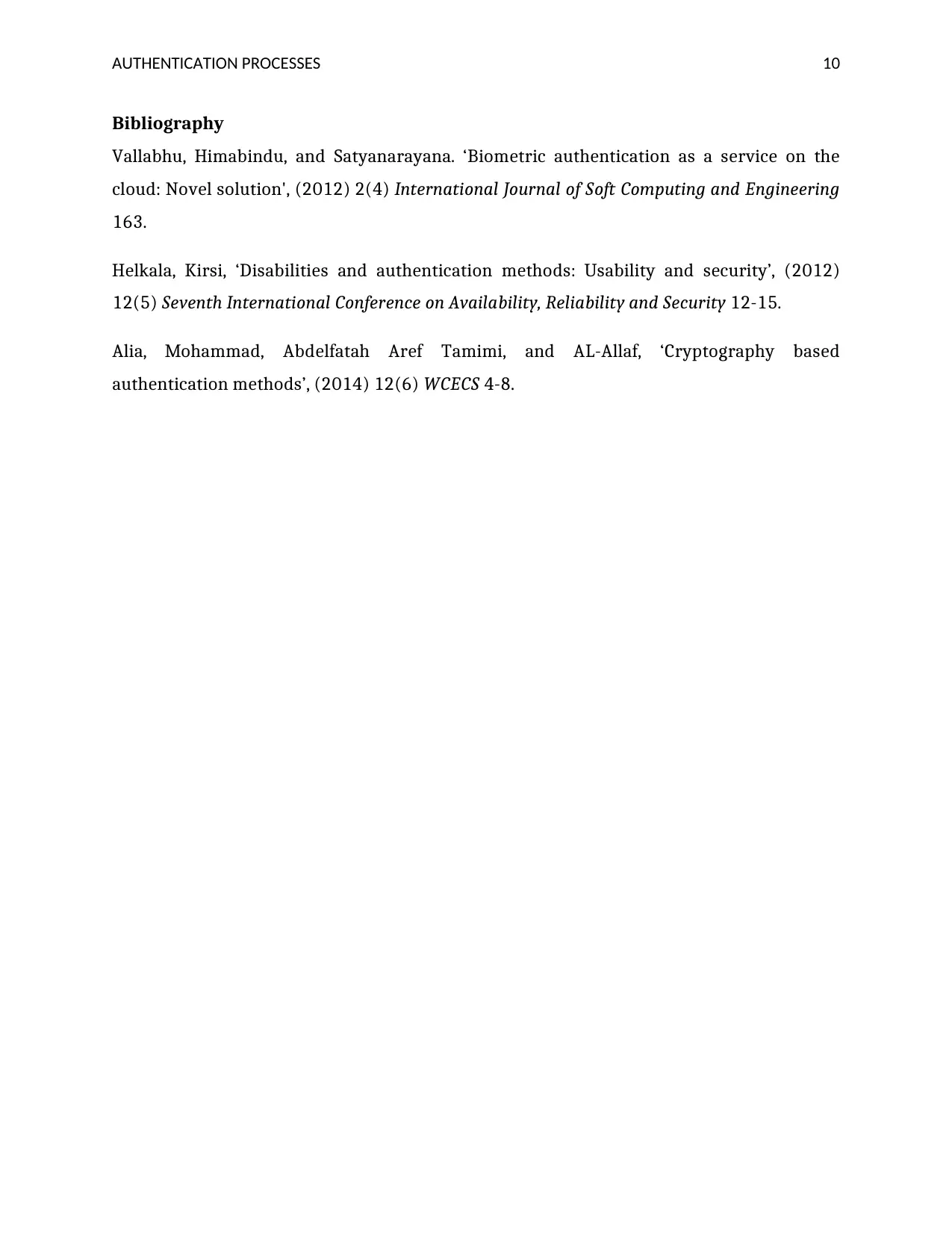
AUTHENTICATION PROCESSES 10
Bibliography
Vallabhu, Himabindu, and Satyanarayana. ‘Biometric authentication as a service on the
cloud: Novel solution', (2012) 2(4) International Journal of Soft Computing and Engineering
163.
Helkala, Kirsi, ‘Disabilities and authentication methods: Usability and security’, (2012)
12(5) Seventh International Conference on Availability, Reliability and Security 12-15.
Alia, Mohammad, Abdelfatah Aref Tamimi, and AL-Allaf, ‘Cryptography based
authentication methods’, (2014) 12(6) WCECS 4-8.
Bibliography
Vallabhu, Himabindu, and Satyanarayana. ‘Biometric authentication as a service on the
cloud: Novel solution', (2012) 2(4) International Journal of Soft Computing and Engineering
163.
Helkala, Kirsi, ‘Disabilities and authentication methods: Usability and security’, (2012)
12(5) Seventh International Conference on Availability, Reliability and Security 12-15.
Alia, Mohammad, Abdelfatah Aref Tamimi, and AL-Allaf, ‘Cryptography based
authentication methods’, (2014) 12(6) WCECS 4-8.
1 out of 11
Related Documents
Your All-in-One AI-Powered Toolkit for Academic Success.
+13062052269
info@desklib.com
Available 24*7 on WhatsApp / Email
![[object Object]](/_next/static/media/star-bottom.7253800d.svg)
Unlock your academic potential
Copyright © 2020–2025 A2Z Services. All Rights Reserved. Developed and managed by ZUCOL.





